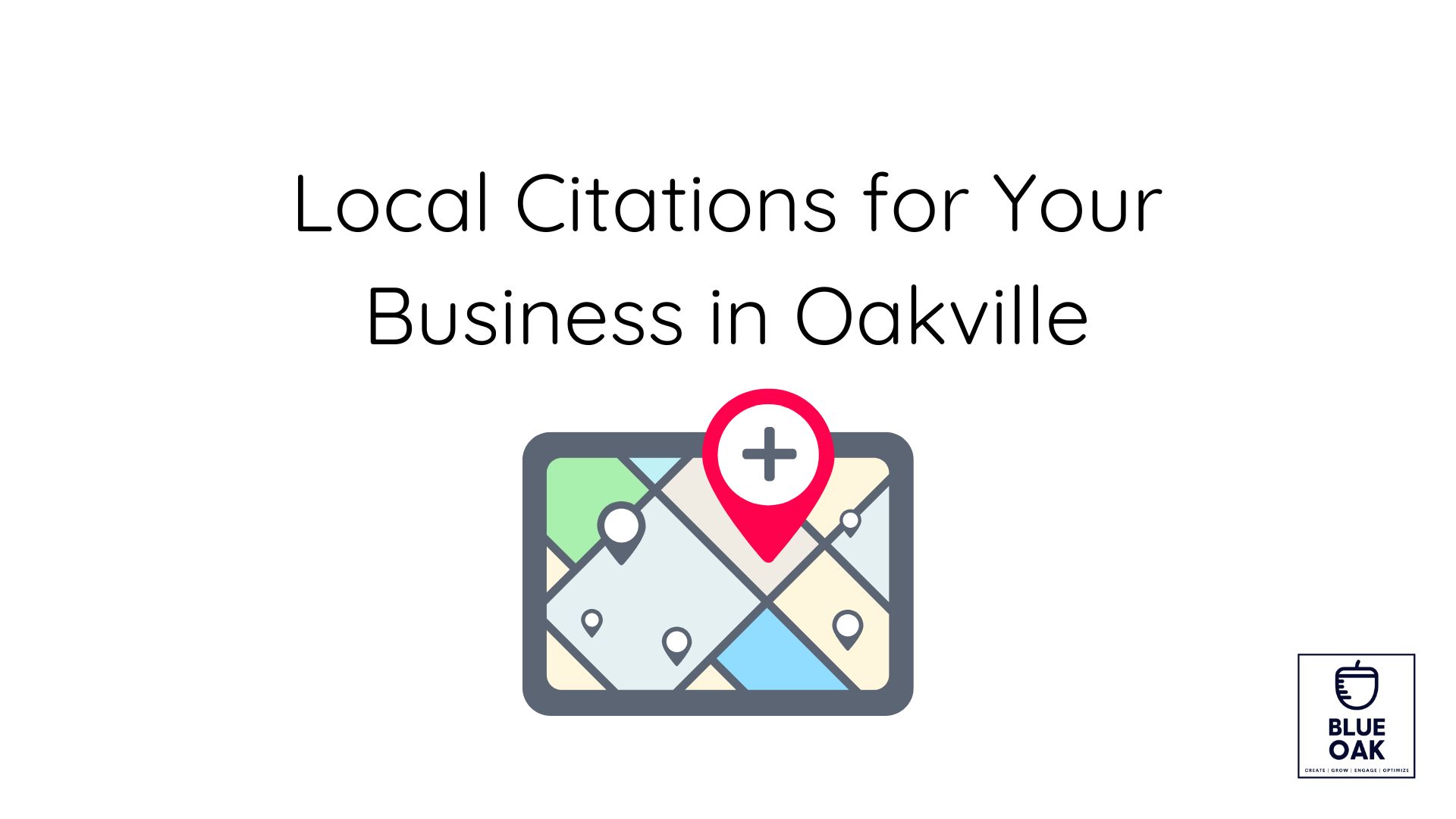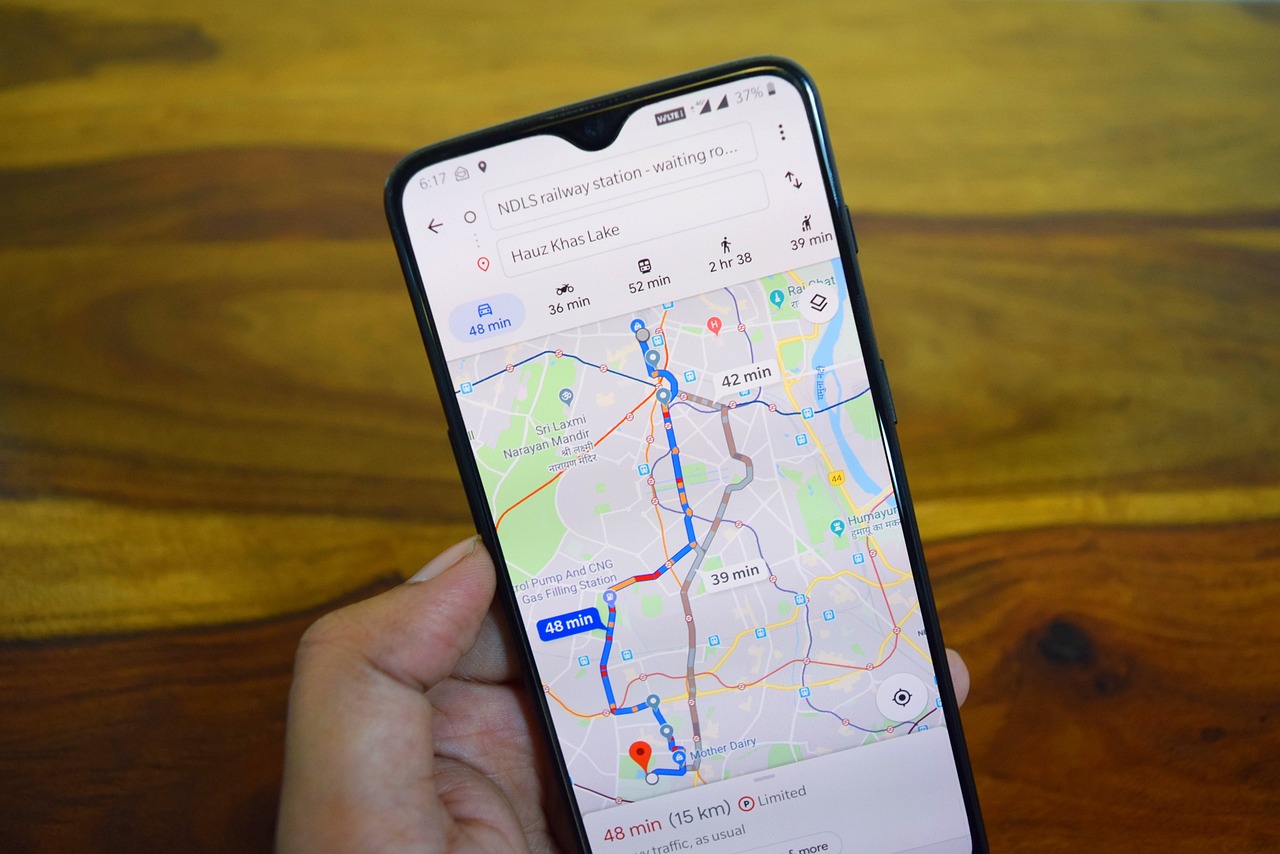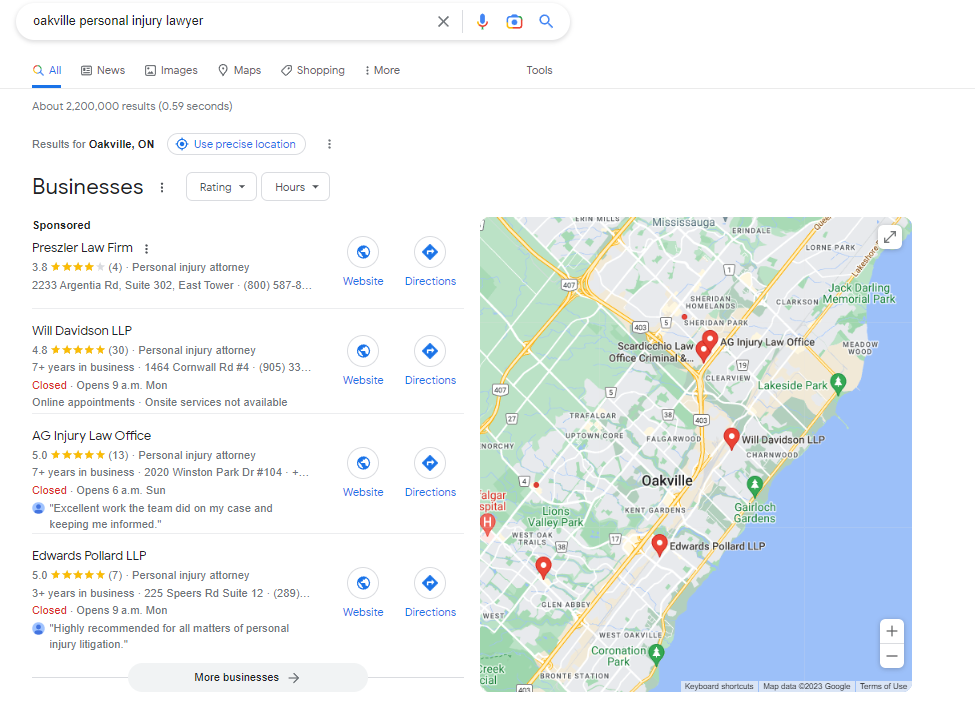Local SEO for Dentists in Oakville
Do you need help attracting customers for your dental practice? And do you also need help attracting clients from the surrounding neighbourhoods of your dental practice and dominating your local dental industry? If this is the case, we would highly recommend that you go through the following blog and learn how you can increase your local client intake as well as improve the online visibility of your dental business in your local community by ranking highly in Google search and Google maps, we would highly recommend that you do.
Table of Contents
ToggleAt Blue Oak Digital, we have developed a comprehensive local SEO approach for dental clinics and dentists that has helped one of our dental clients increase their foot traffic by almost 100% within six months.
What is local SEO for dentists?
Local SEO or Local Search Engine Optimization combines digital marketing tactics to help your dental practice or any other local business rank higher on local Google searches and search engine results pages. So when someone searches for a local dentist, in a particular location, for example, “Dentist in Oakville,” Google will show a search engine result page more focused on businesses near the searcher or within Oakville. This is what Google calls “local search intent.”
Local SEO campaign applies explicitly to businesses with a physical location and would like their customers to visit that location to conduct their transactions of goods and services. Therefore, local SEO is highly recommended for local dentists, law firms, restaurants, spas, and other similar local businesses that require customers to be physically present in their business location. Similarly, local SEO does not apply to companies that want to do their primary business operations online or remotely, for example, e-commerce shops.
Why Should Dentists try to rank in the Google Local Pack?
One-third of your clients use their phones to look for local businesses and services. Among the primary reasons are reading reviews and using the location to navigate through Google Maps.
Higher CTR
Based on the data, around 20% of the users who see search results for a local query click on the number one ranking business on the local pack. This is followed by 15, and 10% clicks to the remaining two firms. This means that around 50% of your potential customers will click only on those businesses that appear on the local bank. The remaining percentage of people will sporadically click on the remaining links in descending order of percentage clickthrough rate.
Customer Reviews
Based on the data, around 20% of the users who see search results for a local query click on the number one ranking business on the local pack. This is followed by 15, and 10% clicks to the remaining two firms. This means that around 50% of your potential customers will click only on those businesses that appear on the local bank. The remaining percentage of people will sporadically click on the remaining links in descending order of percentage clickthrough rate.
More Phone Calls and Enquires
When you rank higher on the Google local pack, you will likely receive more phone calls through your profile and more inquiries regarding your business through your website.
More Brand Recognition
Finally, ranking on search engines for your industry keyword in your local town or neighbourhood will help increase your branch recognition and recall in your local target audience. This would provide a comparative advantage to your business question, local competitors, especially in a business such as dentists, where competition is saturated in towns and cities such as Oakville.
Follow the steps below to create and implement a robust local SEO strategy for your dental practice.
Step 1: Local SEO Audit
Google Business Profile Audit
The first step is to audit your website from a local SEO standpoint. It would help to begin by thoroughly analyzing your Google My Business profile. You should check that your business strategy and subcategories are appropriate for your business for your dental practice, e.g., that your primary and primary category should be a dentist. In contrast, your subcategories can be orthodontic, etc.
Are there elements that include auditing your address, contact information, and hours and ensuring they are appropriate and correct? You should also thoroughly conduct an audit of the images and videos that are uploaded to the little business profile. Remember that your Google business profile is the face of your local SEO and hence needs to be thoroughly analyzed for any potential areas of improvement.
Local Content Audit
The second part of the dental SEO audit is to check the availability and prevalence of your local content. For example, if you are a dentist in Oakville, ON, your website should have a specific page targeting the keyword “Dentist Oakville” in its title and mirror description. In addition, the content should be written and targeted to a user who lives and belongs to Oakville. in case you have multiple locations other than Oakville, for instance, in Mississauga or Milton, you should have a separate page targeting customers in those locations.
Citation's Audit
Local citations are another name for local business directories or business listings websites. These citations help Google confirm all the information on your business profile. Therefore, the more accurate local citations you have, the better your local SEO performance will be. But there is a catch; you need to ensure that all your citations from various local businesses, online directories, and business listings on websites are number one accurate and, more importantly, consistent in terms of their name, address, and phone number (NAP) information to ensure high rank on local search results.
We recommend thoroughly checking your citations through a free tool such as Brightlocal or white spark. This will help you identify duplicate citations, citations with incorrect information, and those you still need to explore to form your business account.
Backlink Audit
Backlinks and their quality are an essential ranking factor for organic SEO and local SEO as it directly relates to your website’s authority. In the backlink audit, we recommend that you check.
- Number of Referring Domains To see if your links are coming from good quality and authoritative domains that are relevant to your dental practice
- Identify opportunities to build new backlinks by looking into your competitor’s backlinks and conducting a backlink gap analysis.
You can use several tools to conduct a backlink audit, including Ahrefs, Semrush, and Moz.
Online Reviews Audit
99% in a recent survey, 99% of the response respondent mentioned that they choose to conduct business with a particular company or service due to its positive reviews online. Online reviews will help your business attract potential customers and, more importantly, establish that trust in your brand.
During the review audit process, look for the following.
- Positive or negative reviews
- The overall number of reviews
- Identify any potential fake reviews that are hurting your reputation.
- Also, identify websites such as Yelp Foursquare and other review websites that you do not have an account.
- Number of Referring Domains To see if your links are coming from good quality and authoritative domains that are relevant to your dental practice
- Identify opportunities to build new backlinks by looking into your competitor’s backlinks and conducting a backlink gap analysis.
Step 2: Conduct Keyword Research
Identify Local Keywords
Identifying the most appropriate keyword is probably the most crucial step in local SEO campaigns if you don’t know what words your potential or prospective patients are using to fulfill or find a dentist or dental service whenever they need it, there is absolutely no point doing a search engine optimization.
The whole idea of SEO is to rank number one, two, or three when on a search engine result page for a particular query; hence, knowing the queries or the relevant keywords you would like to appear for is the most crucial step.
Primary Keyword vs. Service Keywords for Dentists.
We recommend spending as much time as possible determining not just your primary business keyword but also a lot of time identifying the correct service keywords. For example, if you are a dentist based in Oakville, your primary keyword, or the keyword your homepage should be optimized for, should be “dentist Oakville” with a monthly search volume of 1900 searches. Some of the primary keywords we recommend to our dental clients in Oakville are as follows.
- Children’s Dentist Oakville
- Cosmetic Dentist Oakville
- Dentist Oakville
- Emergency Dentist Oakville
- Family Dentist Oakville
- Kids’ Dentist Oakville
- Pediatric Dentist Oakville
Service keywords, on the other hand, are more specific to the kind of dental services that you offer; so, for example, if your dental practice offers teeth whitening, Invisalign, and dental extraction as specialized services, then you should identify the appropriate keywords that people are using within Oakville to identify businesses and dental practices that offer those services on search.
Step 3: On-Page SEO
SEO refers to your website’s HTML and front-end elements, such as title tags, meta descriptions, H1 headers, and Alt-texts. On-Page optimization is essential to ensure your target keywords are part of your website’s copy.
Hence, at this stage, you will now use the keywords identified during the keyword research process and optimize the title tags, meta descriptions, URLs, and Alt text of all the images on your website.
For example, if you have identified the keyword “Dentist Oakville” for your dental practice’s home page as Blue “Oak Dental in Oakville,” the metadata should be developed like the following example.
- Title Tag: Dentist Oakville – Oakville Dentist – Blue Oak Dental
- Meta Description: Our Dentists in Oakville offer family, cosmetic & emergency dentistry. Blue Oak Dental also offers orthodontics, esthetics, and implant dentistry. Call us today!
- H1: Best Dentist in Oakville
Schema Markup and Internal Linking
Other elements of on-page elements include updating the schema markup and optimizing the internal linking of your website pages to ensure that all your important pages related to one another are connected through an internal link. this helps search engines.
Step 4: Create Local Content
What is Local Content?
Local content for local SEO is any web page, blog images, and videos designed to fulfill the needs of local searchers in your community.
We recommend developing local content in the following ways.
- Use local phrases – include local terms such as dentist Oakville emergency dentistry in Trafalgar and Dundas area, etc., in your page and throughout your copy; these local intent phrases and words help the search engine tag your current content with your location.
- Names of cities and towns in your copy – including the names and towns you are targeting in your geographic area can be beneficial and further enhance the local intent signal you want to give the search engines. For example, you can mention Oakville, Mississauga, Halton, and similar terminologies to fulfill that purpose.
- City-specific landing pages – another way is to create local location-specific or city-specific landing pages. For example, if you have your dental practice in Oakville water down and Mississauga, then instead of having a single page targeting all three locations, you should develop three separate pages with specific content for each of the pages and then include information specific to that city and its population within that page.
- Local events – if your business takes part in local events of the city or town you’re based in, it will help from a local SEO perspective if these events or activities are mentioned on your website. Here by increasing the connection of your website to your geographic location in a more robust way
Step 5: Setup and Optimize Google Business Profile
We would be correct if we said that Google’s Business Profile is essential to your local SEO strategy. Optimizing your Google business profile with the correct information and best practices would help your business appear more frequently in local searches than in any other action. Ensure the following steps to opt fully optimize your Google business profile.
Business Name
Ensure that you have your full business name, mainly if it contains the target keywords of your industry. Also, ensure no keyword stuffing is in the business name; otherwise, Google can block or reject your account.
Business Address
Your address should include the correct unit number, street address, and postal code. In addition, you must ensure that the NAP (Name, Address, Phone Number) is accurate across all citations and listings of your business, including, of course, your Google business profile.
Business Description
Include a user-centric business description of at most 750 characters. This description should convey your business’s core benefits, values, and relevance to the target market.
Primary and Secondary Categories
You should identify the correct category for your business. For example, if you are a dentist in Oakville, your main category should be “dentist.” there are also options for including subcategories.
Business Hours
Include the correct hours of operation for your business to avoid any customer bounces that can lead to negative reviews on your profile.
Phone Number
Provide the latest phone number to reach out to your business. Ensure that all other citations also include the same number for your business.
Website
Include the most appropriate link, preferably to your home page.
Product or Services
Include a brief description of your products and services. Make sure that you include as many products and services as possible it is also helpful to incorporate the correct keywords through keyword research within the product and service descriptions.
Photos and Videos
Photos increase the trust factor of your Google business profile in front of consumers. Therefore, we highly recommend taking pictures of your business, team, services, equipment, and in as high-quality photo format as possible.
GBP Posts
Google business profile posts are posts of content on your GBP listing. The purpose behind your Google business profile post is to engage your customers and keep them informed of any activities about the specific location of your business. For example, you can include event invites, discount announcements, etc., to keep your community engaged and informed.
Posts are also a great way to increase conversions through your Google business profile.
Step 5: Review Management
Most potential dental patients and clients read online reviews of your business and competitors before choosing a particular dentist service. Online reviews help customers shortlist their preferred companies, compare one industry to another and ultimately decide which business they want to conduct their transaction with.
Review management is a considerable part of local SEO. Still, we will summarize some actions you can take to increase and improve your reviews online to convert more customers to your business.
Review Generation
We recommend generating reviews on multiple platforms, including Google business profile Yelp Foursquare and other highly visited and trusted review platforms. In addition, for the dentist, there might be several other dentist-specific review platforms, such as Opencare, etc., that your dental practice can develop reviews on.
Reviews can be generated in several ways, including asking for reviews from your loyal customers through SMS, e-mail, or in person. In addition, customers can be incentivized through several ways to provide reviews, such as a discount or gift card.
Review Monitoring
There needs to be more than just generating reviews; active monitoring and management of studies are also required to maintain and uphold your ratings on each platform. We recommend employing tools such as bright local or white spark to help monitor reviews of your various business locations. Subsequently, actions can be planned or taken based on your review scores across multiple platforms.
Responding to Reviews
One of the most important ranking factors from a reputation management or review management perspective for local SEO is that your business responds to positive and negative reviews online. We recommend assigning a resource or an agency to help you manage the review generation monitoring and response.
Step 6: Citation Management and Local Link Building
As you would have identified in your local SEO audit, if there is a gap in your citations in your niche, you need to have a detailed citation-building plan for your location. We recommend the following ways you can build your citations.
Local Directory Listings
Local directory listings include your listing in Oakville Dentists Directory, Canadian Yellow Pages, website.ca, etc. These local listings should come from directories or websites based in Oakville, Halton, or a nearby region to give a powerful local signal to Google and your website.
National or Regional Directory Listing
These citations include the primary site, including apple maps, Facebook, Yelp, Bing Places, Yellow Pages, and Four Squares. These are highly trusted, and high domain authority websites side building citations on these platforms would help increase your business and website domain authority.
NAP Consistency
The most crucial element of citation building is ensuring NAP consistency across all listings, especially your Google business profile, is observed. These discrepancies in your website phone number, address, or postal code would confuse search engines about your location.






